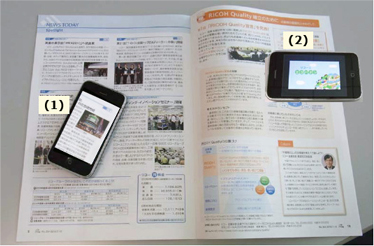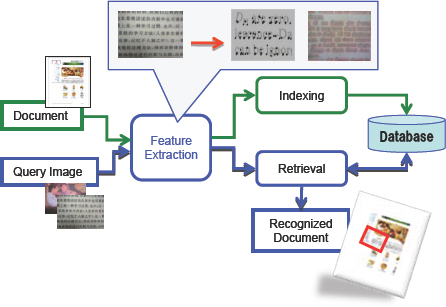- Home
- Technology
- Ricoh's Technology
- Ricoh Visual Search (RVS) Technology
Ricoh Visual Search (RVS) Technology
What is Ricoh Visual Search (RVS)?
RVS technology establishes the relationship between information on printed paper with digital information and services on the Internet. This technology has been developed by Ricoh Innovations Corporation in Silicon Valley, U.S.A. RVS replaces unsightly two-dimensional bar-codes and QR codes and instead establishes link areas to any portion of a document before or after printing. It offers a flexible and natural connection between paper media and digital content or services and offers the potential of new applications and services.
Sample Application
As an example, capturing a portion of a magazine article with a smartphone camera, the RVS server provides relevant on-line information and services related to article (Figure 1).
The RVS process is as follows: an authoring process enables data associated with the article to be uploaded to the RVS server. The captured image is sent to the RVS server and identified. Digital information related to the captured image is located and provided to the user' s smartphone.
 (1) Capturing a part of a magazine with smartphone camera.
(1) Capturing a part of a magazine with smartphone camera.
(2) Document is identified in the database and the related information is sent to user' s smartphone.
Figure 1: Sample application of RVS technology
Features of Ricoh Visual Search (RVS)
RVS technology has the following key features that can support a wide range of applications.
- There is no need to dedicate valuable space to unsightly bar codes or QR codes
- RVS capability can be added to printed documents without requiring any editing or reformatting
- Any type of document can be recognized, including text (in any language), figures, photographs or a combination of these
- Dedicated on-line information can be linked to multiple areas within a single document
- RVS can recognize low resolution images, enabling high speed and robust recognition
Technology behind Ricoh Visual Search (RVS)
RVS technology includes innovative recognition algorithms, data authoring and search technologies. The recognition technology uses image characteristics of printed/captured image similar to fingerprint matching recognition (Figure 2).
 Figure 2: RVS Technologies
Figure 2: RVS Technologies
Potential Applications
RVS technology is applicable to publications and any kind of printed media including newspapers, magazines, books, brochures and posters. All types of digital information or services can be linked including multimedia content, web sites, e-commerce services or social network services.
Video 1 introduces an application linking a driving manual to an on-line video, clearly explaining driving skills. This kind of application allows users to obtain more detailed information which is difficult to communicate on paper.
Video 1: Application linked to a video in a driving manual
Additional applications include linking content of a brochure to e-commerce sites. For example, by capturing an image of a product in a mail-order catalogue, you can review detailed information on your smartphone and instantly purchase the product. This combination of printed content and digital information provides updated information and allows an easy and quick method of purchase.
Finally, RVS technology can add additional information and services after printing. As an example, after capturing an image of an exhibition program on a smartphone, additional information including audio comments or text can be captured and associated with this image. RVS can then be used as ‘sticky note' enabling these comments to be retrieved at a later date. This type application allows an easy way of managing information with mobile devices.
Sorted by : field “Image Processing / Analysis” | product type “Solutions”

